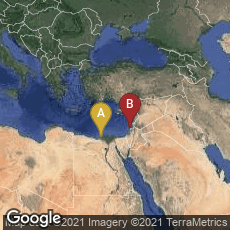For confirmation of the layout of the codex page openings of the Hexapla we depend upon later evidence: two early manuscript fragments that survived. The first is a palimpsest from the Cairo Genizah in which the 8th century Greek text of a portion of the Psalms in the columnar form of the Hexapla was overwritten in Hebrew. This leaf, preserved at Cambridge, was first reproduced by Charles Taylor in Hebrew-Greek Cairo Genizah Palimpsests from the Taylor-Schechter Collection, Including a Fragment of the Twenty-Second Psalm According to Origen's Hexapla. (1900),plate 1.


A: Alexandria Governorate, Egypt, B: Caesarea, Haifa District, Israel
After his arrival in Caesaria, Palestine, from Alexandria, in 234 Christian scholar and theologian Origen (Ὠριγένης Ōrigénēs or Origen Adamantius) undertook compilation of the Hexapla, an elaborate tool for textual criticism of the Hebrew Bible containing the Old Testament written in six parallel columns laid out across each page opening, in a series of large, thick codices. The project is thought to have taken roughly 20 years to complete, by Origen with a team of assistants and scribes, some of whom may have been slaves. To undertake his scholarly work Origen collected a very significant library, though we have little understanding of its precise contents.
Origen was the first Christian biblical scholar, and the first Christian scholar to undertake the study of Hebrew. His Hexapla was not only a massive scholarly achievement in the early days of Christianity, but also a landmark in book history, since the Hexapla was undoubtedly the largest scholarly endeavor in the early history of Christianity—a work so large in terms of sheer information quantity that it could only have been written in a series of large codices, the format of the book that was gradually replacing the papyrus roll between 100 and 400 CE. In papyrus roll form the Hexapla would have occupied hundreds of rolls, and would have been virtually impossible to use, a consideration which would have assured that the codex format was employed. The volumes of the Hexapla were also presumably the first codices to display information in tabular form– a form that Origen appears to have invented.
It is estimated that the original Hexapla consisted of about 6000 folio pages in perhaps 40 codices, and that because of the immense cost of its production- perhaps 150,000 denarii based on Diocletian's price edict- it probably existed in only a single complete copy. This copy may have been preserved in the library of the bishops of Caesarea for several centuries, but was lost in the Muslim invasion of in 638, if not earlier. The three column page format of the large codices of the Hexapla is thought to have been influential on the four column format of the other large codex produced about a century later, which did survive— the Codex Sinaiticus. It is, of course, also likely that the Hexapla was used in editing the Bible text recorded in the Codex Sinaiticus. Origen's table format was also influential on the development of Eusebius's table format in his Chronicon.
Because so little physical evidence survived from the transitional period from the papyrus roll to the codex during first four centuries CE, details that we have of Origen's Hexapla and its relationship to Eusebius's Chronicon and to the Codex Sinaiticus are significant markers for this critical early period in book history. Only a few small fragments of codices have survived from the third century, and nothing from that date confirms the tabular form of the Hexapla, or even that it was written in codex form. For confirmation of the layout of the codex page openings of the Hexapla we depend upon later evidence: two early manuscript fragments that survived. The first is a palimpsest from the Cairo Genizah in which the 8th century Greek text of a portion of the Psalms in the columnar form of the Hexapla was overwritten in Hebrew. This leaf, preserved at Cambridge, was first reproduced by Charles Taylor in Hebrew-Greek Cairo Genizah Palimpsests from the Taylor-Schechter Collection, Including a Fragment of the Twenty-Second Psalm According to Origen's Hexapla. (1900),plates 1 and 2. (I discovered this publication detail when I acquired a copy of Taylor's book in 2016.) More recently the leaf was reproduced on p. 97 of Grafton & Williams, Christianity and the Transformation of the Book. Origen, Eusebius, and the Library of Caesarea (2006) On p. 99 of the same work the authors reproduce a diagram showing the layout of the partial Hexapla leaf showing its actual linear and columnar arrangement in white and a hypothetical reconstruction of the original folio page opening in six columns in gray. The other fragment, coincidentally also of the Psalms, preserved in the Bibliotheca Ambrosiana in Milan, was written in Greek minuscule circa 900, and palimpsested with a 13th or 14th century Greek text.
For further support of the written format of the Hexapla we depend upon the account of Jerome:
"Our best ancient evidence for the form and content of the Hexapla comes from Jerome, writing in Palestine at the end of the fourth century. Jerome knew the work well. Not only did he possess Hexaplatic volumes of his own, which he used extensively in his translations and commentaries, but he also consulted the original at Caesarea. In a brief aside in commentary on the pseudo-Pauline letter to Titus, he gives a detailed account of the work. Jerome says that in the original Hexapla preserved at Caesarea:
"the very Hebrew words, too, are copied in their own letters, and expressed in Greek letters in the neighboring column. Aquila also, and Symmachus, the Septuagint, and Theodion hold their places. But for not a few books, and especially those which among the Hebrews are composed in verse, three other editions have been added, which are called the fifth, sixth, and seventh translations; they are considered authoritative though the names of the translators are lost."
"Jerome thus confirms the presence of a Hebrew column in Hebrew letters as well as a column in Greek transliteration, which gives an unambiguous description of the order of the columns" (Grafton & Williams, op. cit. 91).
Study of surviving fragments of Origen's Hexapla continued over the centuries. The first edition considered comprehensive was Bernard de Montfaucon's Hexaplorum Origenis quae supersunt (2 vols., 1713). This was superceded by the edition of Frederick Field (1875).
(This entry was last revised on 02-24-2016.)